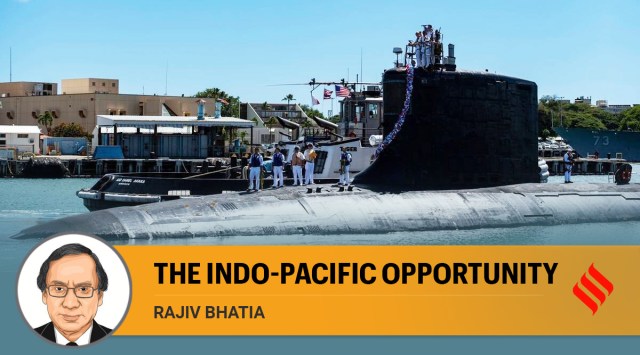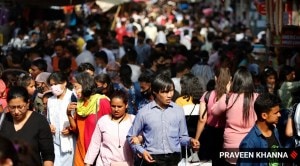- India
- International
In 2022, India should keep an eye on Indo-Pacific
🔴 Rajiv Bhatia writes: The region will present strategic and economic opportunities that India must not miss
 The geopolitics and geo-economics of the Indo-Pacific will be largely shaped by the interplay of relations among nine key nations. (AP Photo/Representational)
The geopolitics and geo-economics of the Indo-Pacific will be largely shaped by the interplay of relations among nine key nations. (AP Photo/Representational)“Yesterday is a foreign country — tomorrow belongs to us,” stated Thabo Mbeki, former president of South Africa, in 1998. Never was this truer than for 2020 and 2021, which experienced globally transformational events. And nowhere more than in the geopolitics of the Indo-Pacific, which is changing at multiple gears and levels. As it moves into 2022, the region will carry the imprint of the past five years, and will have to chart a course through inter-state tensions and crises, using both diplomacy and military preparedness.
The region is central to world economy and peace, and nine countries are key players: the US, China, Japan, India, Germany, the UK, Russia, Australia and France. The geopolitics and geo-economics of the Indo-Pacific will be largely shaped by the interplay of relations among these nations.
Of paramount importance is the US-China equation. As the Trump era ended last January, there was uncertainty over whether the next president would be tough or soft on China. President Joe Biden has demonstrated, in his first year, his formula of firmness, resilience and civil discourse. Expect this relationship to be marked by continually adversarial, competitive and cooperative traits.
Differences over Beijing’s south/east China policy, aggressive postures towards Taiwan, human rights violations in Xinjiang, the subjugation of Hong Kong’s citizenry and assertive economic outreach in the Indo-Pacific — these will weigh heavily on US-China relations. Through its active diplomacy — a series of high official visits starting with Vice-president Kamala Harris — and reaffirming commitments to treaty allies and partners alike, the US signalled it is here to stay. However, it wants the full engagement of its friends to create integrated deterrence and will keep the doors of dialogue open to Beijing. In contrast, Chinese President Xi Jinping, armed with unprecedented authority at home, has been confrontational, as seen in China’s repeated incursions into Taiwan’s air defence zone and the PLA’s obduracy in eastern Ladakh.
In this standoff, the role of new groupings and individual nations is significant. Foremost are the Quad, a strategic partnership between the US, India, Japan and Australia and the militaristic AUKUS (Australia, UK, US). Together, they have arrested the perception of China’s regional ascendency. In 2022, the effort to curb China’s influence can gain further momentum if Japan under prime minister Kishida Fumio announces a bold National Security Strategy (NSS), doubles its defence budget and makes a serious effort to amend Article 9 (which limits the use of its defence forces), thereby expanding military cooperation with the US. Meanwhile, India and Australia are on track to deepen ties, not only bilaterally but also with the other two Quad powers. The next Quad summit, probably hosted by Japan, will cement the grouping.

Two regional groupings — the EU and ASEAN — can determine how they situate themselves in the Quad-China interaction. The EU’s Indo-Pacific strategy, announced last September, aims at increasing its economic and security profile in, and linkages with, the region. The new government in Germany and the April 2022 presidential elections in France will shape the EU’s policy towards this distant region. Only by being more strategic and less mercantilist, more candid and assertive with China, and more cooperative with partners such as India, can the EU — and its former member the UK — hope to become vital players in the Indo-Pacific.
ASEAN, located in the middle of the Indo-Pacific waters, faces the heat of China’s aggression and the sharpening great power rivalry. Its unity is under stress and its centrality is under question. This group has the most work to do. It must enhance its realism and shed its tendency of wishing away problems. Some plain-speaking by the Quad powers with ASEAN governments is necessary; an opportunity will be available when President Biden holds an in-person summit with the 10 ASEAN leaders soon.
The outcome of three major summits in 2022 — G7, BRICS, G20 — will also impact the politics and diplomacy of the region. Germany, as host of the G7 this year, will need to assess if the G7’s 2021 “Build Back Better World” pledge has made any headway in Asia. It now has to cope with not one but two adversaries: China and Russia. All eyes will be on whether Prime Minister Narendra Modi attends the 14th BRICS summit, to be hosted in China. It’s an unlikely prospect unless Beijing shows sufficient accommodation to end the impasse in Ladakh. The G20 summit, to be hosted by Indonesia, will reveal whether the depth of Indonesian diplomacy and capabilities of president Joko Widodo make him a star statesman.
Where, then, does India stand in these swirling Indo-Pacific waters? India has three key obligations. First, to strengthen the Quad – especially by ensuring that the grouping fulfils its commitment to deliver at least one billion vaccine doses to Indo-Pacific nations by December 2022. Simultaneously, India must protect its established relationship with Russia, and show some resilience in dialogue with Beijing. Second, it must enhance cooperation with key Southeast Asian partners —Indonesia, Vietnam, Philippines and Thailand — while humouring ASEAN as a grouping. Third, the eastern and southern planks of Africa and the Indian Ocean island states need continued high policy attention and financial resources. A clear economic and trade agenda, involving and incentivising corporate India to follow the flag in this vital region, is certain to yield long-term dividends.
India has done well by fulfilling its humanitarian duties during the pandemic. Learning how to convert them smartly into economic and strategic opportunities in its periphery is the focused task for the nation in 2022.
This column first appeared in the print edition on January 15, 2022 under the title ‘The Indo-Pacific opportunity’. The writer is distinguished fellow, Gateway House and a former ambassador with extensive diplomatic experience in the Indo-Pacific region.
EXPRESS OPINION
More Explained
Apr 19: Latest News
- 01
- 02
- 03
- 04
- 05










































